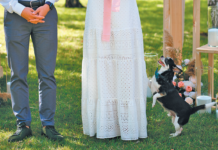Can you name the primary breed(s) of the mixed-breed dog pictured at left? What about the one in the middle? Or that cutie pie on the right?
The answers are upside down in small print at the end of this article, but if you get them wrong, don’t feel bad. So did hundreds of people who work with dogs for a living — veterinarians, veterinary students, shelter volunteers, vet techs (veterinary nurses), trainers, groomers, dog breeders, and so on. Researchers made the finding when they asked more than 900 people across the country who come into contact with dogs either professionally or on a volunteer basis to name the primary breeds of 20 mixed-breed dogs after being shown one-minute, color video clips of each dog that depicted close-ups of their heads and also full frontal and side views. They then compared the answers to each dog’s breed make-up found through DNA analysis. The experiment was published in the American Journal of Sociological Research by investigators at Western University of Health Sciences’ School of Veterinary Medicine, Oregon State University, and the Center for Shelter Dogs (which at the time was a program of the Animal Rescue League of Boston but has since become the main research arm of Tufts University’s Shelter Medicine Program).
Many of the responses were way off the mark. One dog thought to be mainly golden retriever by 40 percent of the respondents turned out to be equal parts golden retriever, American Eskimo dog, Nova Scotia duck-tolling retriever, and Rottweiler. Another, called a border collie by almost half the people asked, was actually a mix of English springer spaniel and German wire-haired pointer with other breeds thrown in for good measure in smaller genetic doses. In all, for 14 of the 20 dogs in the videos, less than half of people’s visual identification matched DNA breed identification. And they were not misidentified similarly. Even agreement in misidentification among the study participants was relatively rare; they named different breeds.

Another surprise: while none of the 20 dogs was a purebred according to DNA analysis, one in three of them was identified as such by anywhere from 10 to 25 percent of the respondents.
Why is this important? Because a visual ID rather than DNA analysis is still the most common method of breed identification, and many adoptable dogs at shelters are being passed over because people are being told by well intentioned but misinformed workers that a dog they may be considering is a mix of breeds that is deemed to have undesirable, perhaps aggressive, behavior. Many of those dogs end up not only unadopted but euthanized. For instance, if a dog is called a pit bull or pit bull mix when it’s not, it could end up as one of the estimated 670,000 dogs killed each year because of an inability to make its way to a loving home. A number of municipalities across the country have restrictions on pit bulls in addition to other breeds, saying they need to be muzzled when outside or not allowed in certain apartment buildings, so people will pass them by. Oftentimes, people will pass up a pet deemed a specific breed because homeowners insurance policies become more expensive when a dog identified as that breed is in the home. Presumably, such restrictions come from an expectation that the dog is more likely to attack someone than a dog of another breed.
Yet people’s ability to identify a dog that has, say, pit bull in it is shockingly lacking. Many look for what they believe is the telltale blocky head and muscular body, but get this: in a study conducted by researchers at the University of Florida’s College of Veterinary Medicine, when 16 staff members at four different shelters — veterinarians, animal control officers, and other people who identify breed mixes routinely — were asked to assign a breed to 120 different dogs, they said that 62 of them were pit bull types — American pit bull terriers, American Staffordshire terriers, Staffordshire bull terriers, and so on. (“Pit bull” itself is not a recognized breed.) That’s more than half of the dogs examined. But DNA analysis showed that only 25 percent of the dogs were actually pit bull type breeds — 30 dogs altogether rather than 62. For instance, one supposed pit bull was largely Irish water spaniel, Siberian husky, and Boston terrier. Another was shown upon DNA analysis to be mostly boxer and Alaskan malamute. Such mistakes could have consequences for people as well as dogs. Someone who adopts a dog misidentified as a pit bull mix could be denied housing because of rules against pit bulls when the dog doesn’t even have any pit bull genes.
Interestingly, the lead researcher of the study discussed at the beginning of this article, Victoria Voith, DVM, DACVB, PhD, found that when some people are given DNA analysis of dogs they have incorrectly identified, they insist that the DNA results must be wrong; they are that sure of their ability to identify a dog’s breed visually, even in the face of evidence that identifying breed composition of mixed breeds is very hard to do — if not impossible.
How could so many people, including people who work with dogs regularly, so consistently get it wrong? It’s because, as researchers writing in The Veterinary Journal have put it, “mixing breeds is not like mixing paint.” When you mix paint, you know you’re getting x percent of this color and y percent of that, and the difference will show up in the hue you put on the wall — consistently. There’s no deviation. But genetics doesn’t work that way. A litter of dogs coming from a sire and dam of two entirely different breeds will not look like a perfect mix of the two. Some will look more like one, some more like the other, and some like neither. Just think of golden doodles and their differences in size and color. You can’t with any certainty nail down, as with paint, what you’re going to get when you do the “mixing.” Go down another generation or two, with more breeds thrown into the mix, and the physical possibilities become even more varied.
How shelters are responding
Now that DNA analysis of breed makeup is available and showing not just in the studies mentioned in this article but in a spate of studies that have been published over the last few years that identifying breed by a dog’s looks is unreliable, more and more shelters are deciding not to take a stab at breed naming. Instead, they are calling their dogs available for adoption “American shelter dogs.” Even the American Kennel Club, the organization you might call the keeper of the breeds, has adopted the term “all-American dog” to refer to mixed-breed dogs who compete in obedience, agility, and rally competitions rather than trying to guess which breed the dog is most like. Emily McCobb, DVM, the Director of Shelter and Community Medicine and Assistant Director of the Center for Animals and Public Policy at the Tufts Cummings School of Veterinary Medicine, and Seana Dowling-Guyer, the associate director of Tufts’ Center for Shelter Dogs, are all for this non-breed-guessing approach. It’s not just because people get wrong which dogs are so-called bully breeds like pit bulls and which have reputations for being easier to get along with. Just as importantly, it’s that “within any breed, there are individuals,” Ms. Dowling-Guyer says. “To make an assumption about all dogs in a breed is almost like racial profiling, she comments.
It’s easy enough to understand her take. Italians and Spaniards and others born along the Mediterranean coast are often thought of as being warm and outgoing and having fiery tempers, but there are plenty of reserved, quiet people in that part of the world. They are not all olive-skinned and dark-haired, either. Some are blonde, blue-eyed, fair, and so on. Similarly, we think of Scandinavians as “holding back,” not prone to obvious displays of mood or affection. But lots of Scandinavian people are emotive and ready to share their feelings — and not necessarily fair-haired and light-skinned. Just as you can’t pigeonhole people according to their “breed,” you can’t pigeonhole dogs.
That’s true now more than ever. Historically, dogs were bred for their behavioral characteristics — the inclination to hunt, or guard, herd, or sit in people’s laps. Dogs of a particular breed did not even necessarily resemble each other physically. In fact, dogs were not called pointers or hounds, for instance, but simply “hunting dogs.” As recently as the 1800s, any dog used for tracking was considered a “bloodhound.” But since the turn of the last century, that has largely been no longer the case, as dogs have gone from being working members of the family to simply pets. Now they are bred primarily for appearance and not as much for behavioral traits. Because an inclination to act a certain way is no longer being selected for as strongly, dogs who look alike — that is, dogs of a certain breed — are less likely to resemble each other in deportment. To put it succinctly, it is less likely that two dogs of the same breed will behave similarly even though they might look more alike than they would have 100 or 200 years ago.
At least as important, if not more, how a dog comes to behave is an extremely complex process that involves what has gone on in its environment — how it has been socialized and treated. This is especially salient for the millions of mixed-breed dogs in shelters, whose inborn proclivities could have been nurtured in any one of a number of directions.
It’s for that reason that Ms. Dowling-Guyer says that “we suggest evaluating a dog as an individual” when deciding whether to take it home. “How does it behave? Is it a good fit for your family?” Shelter workers should be able to tell you how the dog has been reacting to people and other dogs, whether it is likely to turn aggressive or has an easygoing temperament.
Dr. McCobb agrees, advising potential adopters to “blame the deed, not the breed. Mixed-breed dogs in this country have been stigmatized,” she says, because of faulty notions that looks are a foolproof indication of behavioral traits, reminding people that two mixed breeds can create “wildly different looking pups from the same litter” who don’t act the same and that even crosses of two purebred dogs that are different breeds can produce very different-looking puppies who also are inclined to behave very differently. Research has proven it directly. In one study, the “grandchildren” of cocker spaniels and basenjis who were mated looked so different from each other that they were as likely to be identified as predominantly Labrador retriever, beagle, or springer spaniel as cocker spaniel or basenji mixes. The physical identifiers get muddied very fast, as do the behavioral inclinations.
Bucking the tide of trying to identify the breed makeup and personality of a mutt just by looking is not easy. In many shelters, the software packages that help staff track the dogs coming in to see how long it takes them to get adopted have a field that require workers to list a breed from a drop-down menu. It can’t be left blank. So even if a shelter wants to call a dog simply an American shelter dog, “they are held hostage by the software,” Dr. McCobb says. That, in turn, could affect which dogs get adopted — and how quickly — and which get put down because the shelter simply doesn’t have room to keep taking in more and more dogs.
Don’t fall into the trap. Sure, everybody wants to know the breed of a dog. It’s one of the most common questions that gets asked. But when adopting a dog from a pound or shelter, or ad-vising someone else about it, keep in mind that looks truly are deceiving as clues to behavior. Much more important than asking the breed is asking how the dog is likely to get on in your particular household and what you can do to ease the transition — or whether you should pass on a dog who looks interesting but wouldn’t be a good fit for the people under your roof.





